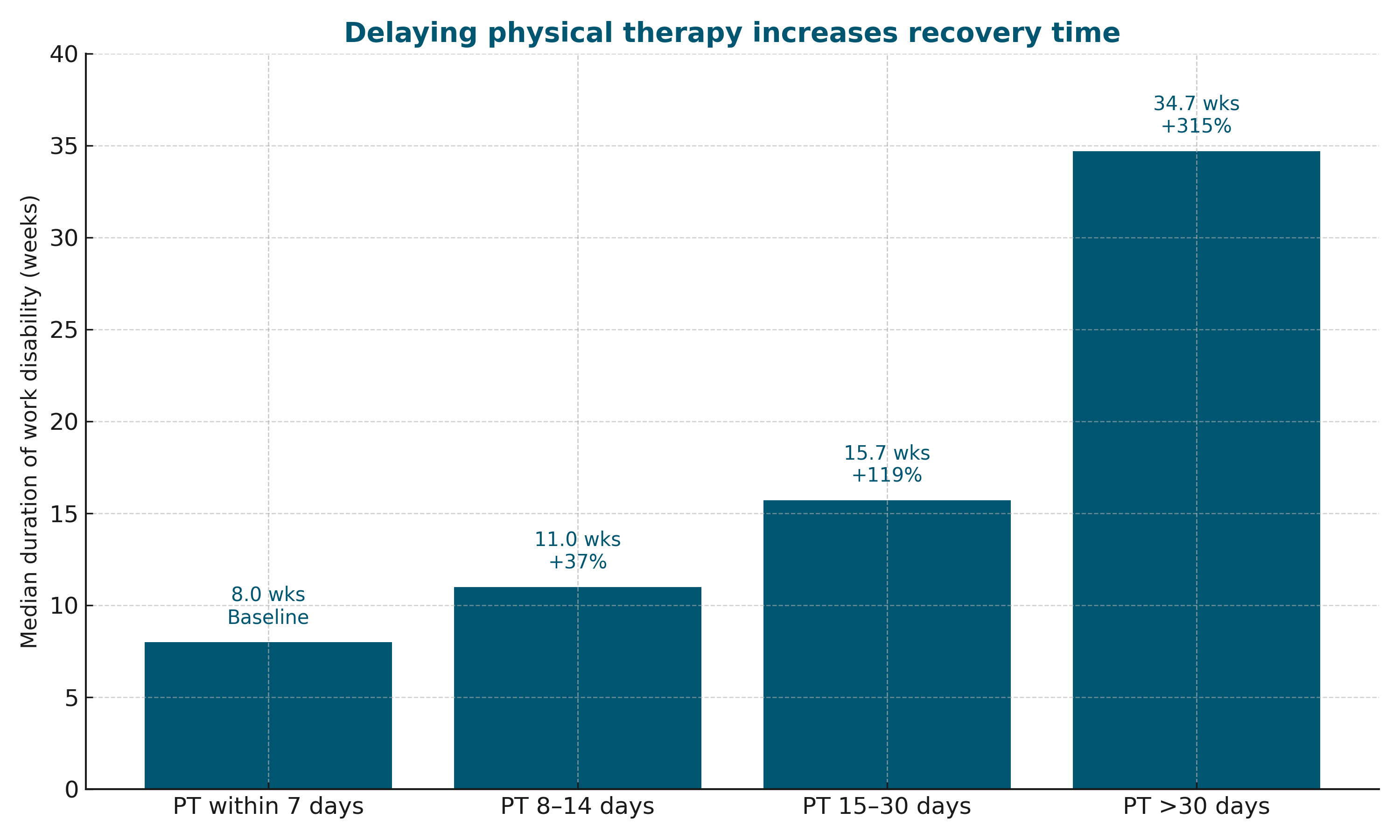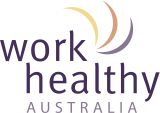
Onsite treatment allows injured workers to receive physical therapy as soon as pain or injury occurs, leading to a much faster recovery.
Early reporting and treatment of injuries significantly reduce recovery time, improve return-to-work outcomes, and lower costs for employers.
According to a recent Monash University research study, workers who started physical therapy within 7 days of injury recovered in a median of just 8 weeks — compared to nearly 35 weeks when treatment was delayed more than 30 days.
Yet despite policies and good intentions, many injuries still go unreported, often until they become far more serious and costly to manage. That’s exactly what happened to Jack, a new council landscaping employee who thought he was doing the right thing by saying nothing.
When injuries fall through the cracks
Jack had just started a job with a local council. Over the weekend, he helped his mate Pete move house, lifting far more than he should have. By Monday morning, his lower back was sore. But he said nothing. It didn’t seem serious, just a muscle niggle he thought would settle with rest and a few painkillers.
Jack was a hard worker. He didn’t want to seem like a complainer, especially not in front of his supervisor, a no-nonsense manager who had recently dealt with multiple staff on sick leave and was under pressure to keep things moving. The message was clear: this job had to get done, and there was no time for anyone to fall behind.
So Jack kept quiet. He figured the pain would pass and got on with the job.
With several team members still on leave, Jack was lifting, digging, and hauling mulch almost nonstop. As the days wore on, the pain worsened – but with his supervisor pressing everyone to meet deadlines, he felt there was no room to speak up. Jack didn’t want to seem weak, uncommitted, or risk being seen as a problem so early in his role.
Weeks passed. The pain spread, kept him awake at night, and eventually caused shooting sensations down his legs. Only then did Jack visit his GP. He was prescribed strong painkillers, referred for an MRI, and certified unfit for work for at least two weeks.
His injury, once manageable, had escalated. Without early assessment or job modification, Jack’s condition had worsened, turning a minor strain into a more serious injury with greater recovery time and cost.
When Jack finally submitted his certificate of capacity, his supervisor was blindsided. “Where did this come from? What happened? Was it from work, or something you did outside?” Already frustrated by other absences, the supervisor simply told Jack to take his sick leave and come back when he was better.
Why stories like Jack’s are common
Jack’s experience is not unique. In fact, it echoes what happens across many Australian workplaces.
Musculoskeletal Disorders (MSDs) are the most common workplace injuries in Australia, with lifting and manual tasks the leading causes. They may develop suddenly or gradually, and are often made worse by a combination of organisational, biological, and psychosocial factors.
The earlier an injury is reported and treated, the greater the chance of a full recovery, and the lower the cost to both employee and employer.

Early action, better outcomes
International and Australian research shows that early reporting and treatment:
- Reduce the duration of injuries
- Improve return-to-work rates
- Lower overall organisational costs
Faster injury reporting = faster treatment = faster recovery
- Injuries reported within 24 to 48 hours show significantly better outcomes.
- Even a delay of a few days can increase claim costs and recovery time.
- Supportive organisational culture plays a major role, particularly supervisors trained in early injury management.Research shows that early injury management can reduce compensation claims by up to 46% and improve return-to-work rates.
- Early modification of duties for those with high reported pain often leads to faster resolution of symptoms.
Delays come at a cost: what the research tells us
A study by Monash University looked at 9,160 workers’ compensation cases involving lower back pain. The findings were clear:
Recovery time increased significantly the longer treatment was delayed:

Why reporting and treatment get delayed
Despite the evidence, many workplace injuries still go unreported or are not reported until later. Common barriers include:
- Off-site clinics that are hard to access
- Waiting lists and long delays
- Fear of repercussions or job loss
- Language or cultural barriers
- “Tough it out” mindset among workers
- Unsupportive or unskilled supervisors
- Lack of awareness of how early treatment improves recovery
- Ineffective internal communication and reporting systems
Substantial evidence shows that early commencement of PT [physical therapy] may effectively improve outcomes for individuals with LBP [low back pain], including a reduction in work disability.
What can organisations do differently?
To reduce injury escalation and improve recovery outcomes, consider these best-practice steps:
- Encourage immediate reporting. Educate workers that early reporting is a sign of strength, not weakness. Reinforce the value of health over heroics.
- Offer easy access to onsite treatment. Onsite clinicians familiar with the workplace can provide same-day care, helping prevent small issues from becoming serious.
- Don’t ignore non-work injuries. Early intervention can prevent aggravation and time off, regardless of where the initial pain began.
- Train supervisors to spot early signs. Equip leaders to recognise when workers are struggling physically or mentally – and to respond with support, not blame.
- Foster a positive safety culture. Make it normal – and expected – for workers to speak up, seek help, and prioritise their health. Greater perceived workplace support is associated with shorter workers’ compensation claims.

A strong culture of reporting builds a stronger workforce
Jack’s story could have ended differently – with a short-term strain managed early and resolved quickly.
When organisations make early treatment easy to access and part of normal workplace practice, they improve recovery outcomes, reduce injury-related costs, and build healthier, more resilient teams.
Reporting is just the first step – it’s access to timely, appropriate care that makes the real difference.
Is your workplace set up for early treatment success?
Many injuries escalate not because they’re severe at the outset, but because treatment is delayed.
Now is the time to review your systems:
- Do employees know how and when to speak up?
- Can they access treatment quickly, without barriers?
- Are your supervisors trained to respond early and support recovery?
If not, it’s time to act.
Work Healthy Australia partners with organisations across Australia to provide onsite injury prevention and early treatment services — helping workers recover sooner and reducing the long-term cost of injury.
Contact us to learn how onsite treatment can support your people and strengthen your safety culture.
Sign up to our monthly enewsletter
"*" indicates required fields
